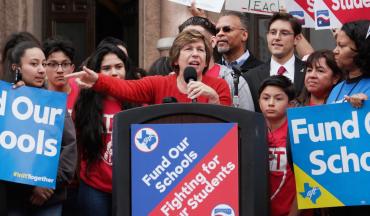Fund Our Future
The wealthiest Americans don’t have to worry about how they will pay for groceries, or a visit to a doctor when they’re sick, or heat for their homes during frigid weather. They never have to think about whether their children will be able to afford to go to college or how they’ll pay for summer programs to keep their children safe when school is out. But tens of millions of Americans are consumed with those worries, and the budget President Donald Trump released last week decimates the very programs that help address the needs of the most vulnerable Americans.
Budgets reveal priorities. They reflect choices. And Trump, whose lavish 2017 tax cuts for corporations, special interests and the ultra-wealthy exploded the deficit to perilous heights, is making choices that are as heartless as they are reckless.
Trump’s budget eliminates funds for community schools, preschools, and after-school and summer school programs in high-poverty areas. It cuts home energy assistance for seniors and people with disabilities. The man who promised “there will be no cuts to Social Security, Medicare and Medicaid” wants to cut all three programs, proposing to slash more than $1 trillion from Medicare and Medicaid. In the midst of the opioid addiction crisis, Trump’s budget guts $12.4 billion from the Department of Health and Human Services. Even the administration’s supposed priorities, career and technical education and child care, aren’t funded in a meaningful way.
At a time when the soaring cost of higher education is saddling Americans with record college debt and putting college out of reach for many people, Trump’s budget would make higher education even less accessible. He wants to eliminate public service loan forgiveness and divert $2 billion from Pell Grants, which help students from lower-income families.
It is no wonder Trump plays so loose with the truth, as it disguises the fact that, by governing to favor America’s elites, he is hurting the very people who thought he would work for them.
It’s not just this administration that has misplaced priorities. Twenty-five states still spend less on K-12 public education than before the recession. And 41 states still spend less on higher education. The lack of appropriate investment is the root cause of every single one of the teacher walkouts that are roiling this country. The Center on Budget and Policy Priorities found that the recent teacher strikes led to substantial increases in school funding in several states, but that funding remains well below 2008 levels in those states, and several have enacted only short-term fixes.
After a decade of neglect and austerity in our country’s schools, the American people have had enough—and want a reordering of the country’s priorities to focus on things that make their families’ lives better. And that starts with our children and sustainable investments in public schools, colleges, infrastructure and healthcare.
That is the aim of Fund Our Future, the AFT’s campaign to demand those in power invest in our public schools and in the resources students need to succeed—particularly children of color, children with special needs, children who are vulnerable and children who live in poverty.
On the same day that Trump and DeVos released their budget abandoning public schools and the families they serve, I was with parents, students and educators in Texas for their Fund Our Future kickoff rally. Texas has a $15 billion Rainy Day Fund, yet the state has cut public education spending by $2.5 billion over the past decade. A Dallas high school physics teacher at the rally said that, if the school district gave her an extra $5,000, she’d spend it on lab supplies and replace the broken chairs in her classroom.
In the first week of March alone, there were 90 Fund Our Future events nationwide, with students, parents and communities joining educators in demanding adequate investments in public schools and colleges. In Illinois, they’re fighting for a fair tax system. In Washington state, they’re calling for investments in community and technical colleges. In Philadelphia, educators and allies are demanding safe learning environments.
In Michigan and New Mexico, we’re working with new governors whose priority is public education, and in places like New York we’re building on progress toward ensuring all, not just some, of our children have access to the public schools and colleges they deserve.
In an ideal world, our elected leaders would use the country’s economic resources to improve people’s lives—to make the American people healthier, better educated and more secure; to promote their potential and create opportunity where it has been denied; and to make the vulnerable among us less so. In reality, we must elect and hold accountable leaders who are committed to funding our future.

